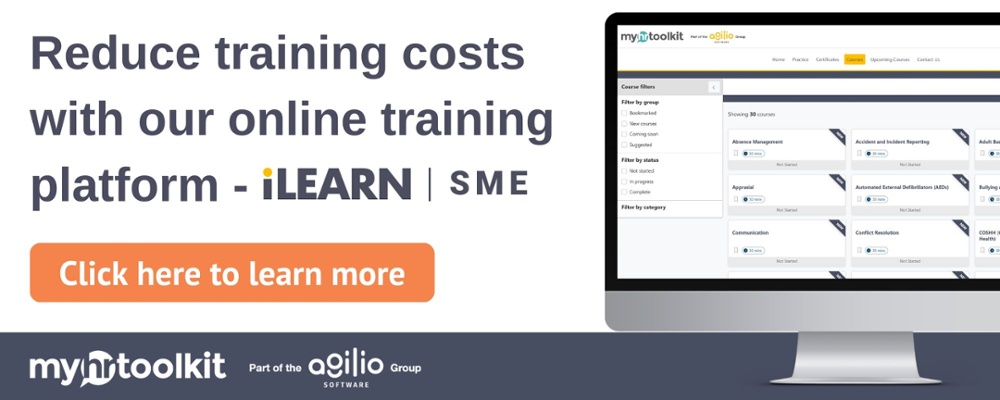Learn how to calculate average training cost per employee to maximise your training budget and develop your employees effectively with this guide from finance writer Sarah Iqbal.
The saying that an organisation is only as good as its employees has never been truer. Employers who commit to nurturing and providing professional growth opportunities for their employees through training reap the benefits of lower staff turnover, a happier team, greater staff engagement and a more knowledgeable workforce.
The benefits of training employees are invaluable. However, there is no denying that there are costs associated with training a new employee, or indeed an existing one. Although this can be discouraging to the smaller business owner, it is necessary to retain your top talent and stay ahead of the competition. In this article, we will look at the various costs associated with training your team, to assist you with maximising your training budget and identifying priorities for your business.
How much does it cost to train a new employee?

When you take on a new employee, you’ll need to invest some money and time onboarding them. Regardless of their skillset and ability to hit the ground running, some basic training will need to be carried out to get them up to speed with the day-to-day tasks involved in their job role.
In the UK, employers spend on average £1,530 per employee training a new employee. If as a small business owner, the figure above has got you worried, we can assure you that this number is just an average; the amount you spend will depend on factors that are entirely unique to your business and your employee’s job role.
For example, you wouldn’t expect someone working in planning and logistics to have the exact same training needs as your marketing manager or warehouse staff. So, it stands to reason that their training budget wouldn’t be the same either.
Calculating a training budget
The first step to working out an employee’s training budget is to understand what training they need, for example:
- What skillset and knowledge does each employee need to do their job effectively?
- What is the best way to build those skills and gain that knowledge?
- Finally, how much does each training option cost?
Calculating average training costs per employee

There is a simple calculation for working out the training cost per employee. That is to take your training budget and divide it by the number of employees you currently have. However, it isn’t always that simple. For smaller organisations, you will have fewer people to train, so you may need to allocate more of your budget to bringing newer team members up to speed. In addition, you may have some senior staff who could benefit from undertaking a professional qualification.
Often, smaller businesses end up spending more on training per employee than larger companies. This is because larger firms benefit from economies of scale by putting high numbers of employees through training simultaneously. However, larger companies spend more hours training employees compared to small businesses.
Determining what type of training is required
Identifying the right training methods for your employees will depend on your industry and the job role being undertaken. Some industries, such as retail and leisure, do not require their employees to undertake extensive training programmes and on the job training with a peer or in-house training manager is sufficient. However, if you work in a technical industry or employ more specialised staff, there may be a need for more specialist training.
Choosing a training programme that is role-specific will keep it relevant and relatable to your employee. For example, if your marketing assistant undertakes a professional marketing qualification such as a CIM professional certificate whilst employed by you, the skills they learn can be directly translated into their job role, meaning they perform better and your business benefits from their training, as well as increasing employee satisfaction.
Track team training courses and employees' personal development activities with a central, online training management system.
How to make sure training is worth the cost

Ensuring your staff have the right skillset to undertake their job role is fundamental to your job as a business owner/manager. Offering training is proven to improve employee performance and increase job satisfaction. However, you need to ensure that the training you provide is relevant, pitched at the right level, and engaging. Interesting and engaging training makes employees feel positive and promotes loyalty amongst the workforce.
Choose relevant and timely training
Ideally, your staff should be able to apply their newly learned skills to their job role immediately for maximum benefit. If you choose training programmes pitched at the wrong level or an irrelevant skillset, you risk your employees becoming disinterested and unmotivated and likely forget their training quickly, rendering it worthless.
Identifying training needs with employees
Part of your employees’ development plan should be to address any gaps in their knowledge with relevant training. When you identify these needs together, your employee is likely to be more motivated and committed to complete that training, moreso than something that they feel doesn’t fit their job role.
Employee training is a critical component of any organisation that wants to succeed and retain its top talent. A better-trained workforce will turn more profit and add values in ways that make it more than worth the cost of investing in your staff by training them. Make sure you set aside a training budget each year for every employee to keep their skills topped up and performing to the best of their ability.
Read more from the myhrtoolkit blog

Written by Sarah Iqbal
Sarah Iqbal is a fully CIM qualified marketing executive and copywriter who specialises in business and finance writing. She regularly writes about how businesses can make profitable investments and use strategies to save on costs and boost revenue.


 Holiday Planner
Holiday Planner Absence Management
Absence Management Performance Management
Performance Management Staff Management
Staff Management Document Management
Document Management Reporting
Reporting Health and Safety Management
Health and Safety Management Task Management
Task Management Security Centre
Security Centre Self Service
Self Service Mobile
Mobile




